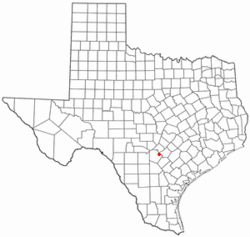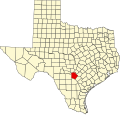City of Universal City | |
|---|---|
 Universal City Municipal Building and City Hall | |
| Motto: "The Gateway to Randolph AFB" | |
 Location of Universal City, Texas | |
 | |
| Coordinates: 29°33′10.381″N98°18′27.274″W / 29.55288361°N 98.30757611°W | |
| Country | United States |
| State | Texas |
| County | Bexar and Guadalupe |
| Government | |
| • Type | Council–manager |
| • Mayor | Tom Maxwell |
| • City Council | Christina Fitzpatrick Ashton Bulman Bear Goolsby Bernard Rubal Phil Vaughan Lori Putt |
| • City Manager | Kim Turner [1] |
| Area | |
• Total | 5.59 sq mi (14.49 km2) |
| • Land | 5.57 sq mi (14.43 km2) |
| • Water | 0.02 sq mi (0.06 km2) |
| Elevation | 764 ft (233 m) |
| Population (2020) | |
• Total | 19,720 |
| • Density | 3,750.45/sq mi (1,448.12/km2) |
| Time zone | UTC-6 (Central (CST)) |
| • Summer (DST) | UTC-5 (CDT) |
| ZIP codes | 78148, 78154 |
| Area codes | 210, 726 |
| FIPS code | 48-74408 [4] |
| GNIS feature ID | 1349101 [3] |
| Website | www |
Universal City is a city in Bexar County, Texas, United States, with a small portion in Guadalupe County. It is a suburb of San Antonio to the northeast, and is adjacent to Randolph Air Force Base. The city also borders Schertz, Texas to its east, Selma to its north, Live Oak to its west, and Converse to its southwest. The population was 19,720 at the 2020 census. It is part of the San Antonio Metropolitan Statistical Area.
